Resource Hub
How integrated data can help public transport networks
Published December 21, 2023 in Blog
What are Integrated Public Transport Networks?
An integrated public transport network combines different transport modes to maximise ease and efficiency for passengers in terms of time, cost, comfort, safety, accessibility, and convenience.
This article reviews transport integration history, the modern environment, and how providing real-time data to the right people at the right time is vital to providing effective integrated transport solutions for authorities, operators, and passengers. It examines technical, operational, and institutional integration challenges, and how data is used by public transport authorities to manage services.
Integrated Networks Through History
Public transport has always needed data. Transport authorities and operators want passengers to know when services are running. Passengers want to know service times to ensure they reach their destination promptly. As technology has progressed, data exchange has increased significantly. What has remained the same is that service and passenger awareness is vital and needs to be managed and coordinated effectively.
Stagecoach services did not have an accurate timetable, but there was still a plan. Passengers had to be available, infrastructure had to be built, and information on service status, flooded rivers, the presence of bandits, or impassable highways was needed. Typically, this information was passed by word-of-mouth between drivers.
When the train arrived, it brought a common time. Time used to be managed locally using the sun, as there were no critical timing constraints before intercity train travel became commonplace. A published timetable needs a common reference time, which required distribution so passengers could board the service punctually. In the 1840s, ‘Railway Time’ was invented.
Timetables used railway time to inform the public. Travellers consulted timetables and other documents to determine their route. Books were created to document railway network details, for example, Bradshaw’s Guides, which Michael Portillo uses in his Great Railway Journeys television series.
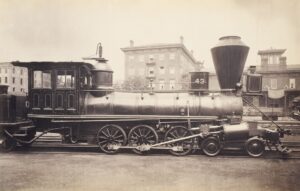
Running alongside the train tracks were signal lines and the telegraph, which started life as a data service using Morse Code. Along these primitive lines, service status information was condensed and distributed. The incoming train status for the cross (English) channel service was an early use, where train information was transmitted to the ferry captain. This was an early form of connection protection.
Modern-day Data Exchange
Data is now a critical component of public transport, with ever-increasing demands and rapidly expanding uses. Data is used to inform passengers and coordinate operations. The driver knows if they are on time or too close to other services, whilst the control centre monitors the vehicle status. Maintenance departments monitor and collect information that is used to optimise vehicle maintenance, which increases service reliability and controls costs.
Wide data use and exchange between services created several possibilities for integration, supported by standards adoption, and synchronised interfaces between systems.
Previously, passengers needed a specific book or website to plan journeys in each local area. Now, journey planners can create trips across regional, national, and international boundaries. These tools combine information from many travel modes, bringing information together in an easy-to-understand format.
Data flow depends on agreed standards. Just as the telegraph used Morse Code, today’s inter-system communications are based on evolving standards.
Once a standard is defined, the specific content style and message meaning need to be agreed upon, for example, how are stops uniquely and unambiguously defined? Should coordinates and all associated information be shared, or can a common identifier be used to simplify integration?
This challenge of agreeing on common meanings needs to be addressed whenever a new standard is introduced. Transmodel (a high-level model of common public transport concepts and data structures), defines a common set of terms and meanings. These are used to develop standards like SIRI.
How do you Create Integrated Public Transport Networks?
Encouraging the uptake of public transport requires integrated thinking – not just of the systems, but the institutions and political objectives. These objectives can often be supported by technical investment and systems.
Consolidating Services
Modern cities need to consolidate and coordinate multiple transport services (e.g., trains, trams, ferries, and buses) and their associated data using technology. When technology is used, it often takes the lead role.
When creating an integrated transportation network, it is important to think about passengers and data communications, as well as how to improve transport through the physical integration of the networks, the fare system, and other institutional aspects.
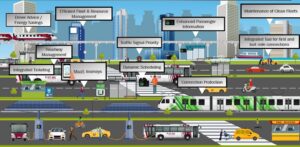
One good case study is the Swiss public transport network (Zurich and surrounds). There are hundreds of connections enabling passengers to travel throughout the country across multiple modes. This information is easily shared across different service providers and computer systems using agreed standards, with mutually agreed codes.
In Zurich, data has allowed the transport authority to increase network capacity and maintain punctuality by applying network-wide planning. This plan allows for more frequent services on fewer lines and provides flexibility.
An integrated network should assist passengers to travel from doorstep to doorstep in a smooth, efficient, and speedy way. Integrating networks in this way leads to reduced travel time.
In Singapore, between 2012 and 2016, the Land Transport Authority (LTA), through integrated transport thinking, reduced the average passenger trip from 53.8 minutes to 50.8[1] – a saving of three minutes. When applied across the millions of passengers that use Singapore’s public transport each day, this is a significant time-saving.
Restructuring
Many regions have introduced the concept of overall transport responsibility under a single organisation e.g., Transport for London. This model enables an integrated approach for the different modes of travel.
Each travel mode has a role – including the bus, tram, ferry, walking, cycling, and even taxis.
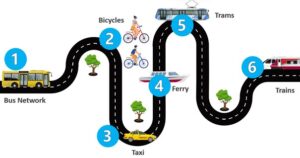
What Can an Integrated System Deliver?
Better Passenger Experiences
The car provides almost infinite flexibility in terms of routes and timing. Public transport is not as flexible, but integrated networks coupled with high-quality information help enable public transport to approach this convenience level. Planning a journey, including the first and last mile, may involve several services – all of which need to be coordinated, not just for individuals, but for all passengers.
Integrated networks greatly enhance passenger experiences
Providing an integrated fare collection system, where passengers use the same media to pay for all transport services, speeds up the whole journey – reducing idle time at stops and providing simplification. Passengers can board and alight without the inconvenience of purchasing a ticket for every journey. The final fare is automatically calculated across the different services used.
Optimised Timetables and Services
With ubiquitous data, timetables can be rethought. If there are no waiting passengers, does the bus need to travel past the stop? Generally, passing a stop is essential to transport passengers, but where there are multiple variants in the service, demand-based routing can improve services without significantly impacting overall delivery.
With dynamic scheduling, alternative routes are only serviced if passengers are waiting, detected either via a mobile application, a subscription, a request button at the stop, or other technologies. In normal circumstances, the bus runs the express route, delivering faster journeys, lower mileage, and less pollution. However, if there is a request on either alternative, the service will divert to these alternative stops.
Using traffic light priority, priority bus lanes, bus queue jumping lanes, and other traffic engineering approaches, when used together with vehicle technology, provides passengers with services that enhance the travel experience.
Passenger Information and Connection Protection
Within interchanges and transport hubs, information guides passengers between services, and within vehicles, displays are complemented by mobile device information. Behind the scenes, data moves continuously between systems.
For instance, if an authority provides connections between train services and buses, information needs to be exchanged – informing the bus system of the train service status.
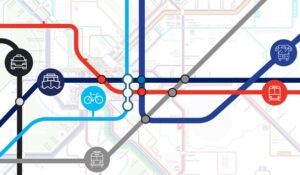
The bus system informs the bus driver they need to hold for two minutes to meet the connection with train services. The transfer status is shown to passengers via displays, which may be part of the real-time control system or a separate passenger information system.
Mobility as a Service
Mobility as a Service (MaaS) is growing and needs to be blended seamlessly into the public transport network. Societal benefits are maximised when the MaaS platform coordinates with public transport operators to provide the first and last-mile service.
Overcoming Challenges
When constructing an integrated transport network, many challenges need to be overcome. The political environment determines the transport focus.
Institutional integration is, in many ways, very complex, as it is a political activity, rather than a purely operational or technical one.
Organisational and Political Challenges
These challenges are addressed by sharing experiences. The growth in Bus Rapid Transit (BRT) systems has occurred because transport authorities have implemented the lessons learnt from places like Bogotá, Colombia, the United Kingdom, and North America. There are even BRT institutes[2] that share knowledge and experience.
BRT is often a public transport backbone that links with feeder services, moving passengers into and out of the network with connections to other modes including metro, rail, and ferries. When these systems intersect, technology improves the integration and further enhances the public transport experience.
When the LTA was mandated to improve public transport in Singapore, they examined the fundamental operating model – should routes be purely commercial, or provide a service to residents? The political objective was to improve services for everyone, so the approach to managing contracts required change. LTA took ownership of where routes operated, including when and how frequently they should run. They then contracted with operators to provide these services in line with agreed requirements.
The technical solution introduced helped collect the necessary data to determine the service quality delivered. It also allowed operators to manage services in line with contract requirements.
Technology Challenges
Technologically, there are also challenges, for example, maintaining data integrity. These challenges need a solution that is both technical and institutional. To share data, it must have a common meaning. While a standard may define the stopid field to identify stops, how this is encoded and made unique within a wider environment to enable cross-boundary travel, is important. This is where the institutional aspects come in – agreement needs to be reached across all parties, and not just at a technical level.
For example, in the United Kingdom, the NAPTAN national stop numbering system is used to enable an authority or region to define stops within their area. It includes a defined prefix that provides authority details, and therefore, the valid area. Internally, a system might only ‘use’ the short local authority code but would still map to the larger NAPTAN number.
To share a timetable, the stopid needs to be understood by all, as they provide the basis for a range of services.
The bus arrival point at a metro interchange should be understood in the context of the larger interchange, so journey planners can correlate bus and train services to determine the walking time between the two.
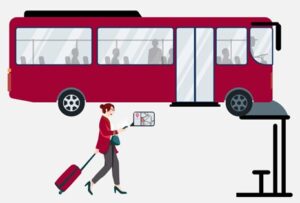
When information is shared between systems, they need to agree on the details – services, the stops, and the interconnections. This sharing platform is built using information exchange standards, and a common agreement on the meaning of exchanged data.
Conclusion
Transport has driven several innovations across society. Integrated networks can trace their origins to the early days of rail travel, and data has been used from Morse Code through to Transmodel and SIRI.
Integration is more than enabling one service to feed into another. It is about having integrated fare models to make travel easier, and accurate, reliable, and widely available passenger information to enable passengers to navigate this interconnected landscape.
- Integrated public transport networks
- Provide great passenger experiences
- Require technology to ensure their success
- Need transport authorities to act as innovation hubs
Transport integration is built on these concepts – by using the message data format, as well as the meaning within the messages. This integration level requires institutions to come together, agree on a common meaning, and enable technology to innovate and deliver services.
It is the integration of data at all levels (and political will) that underpins an integrated public transport service.
That is why we say, Integrated Data = Integrated Public Transport.
Want to know more? Contact us to find out more about how Trapeze Group technology can help improve public transport operations.
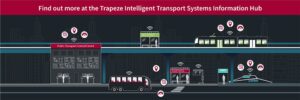
[1] LTA 2040 Land Transport Master Plan
[2] NBRTI – National Bus Rapid Transit Institute. Bus Rapid Transit – Centre of Excellence (brt.cl)
Mode of Transport
Public Transport Authorities, Bus, Trams/Light Rail
Solutions
Intelligent Transport Systems